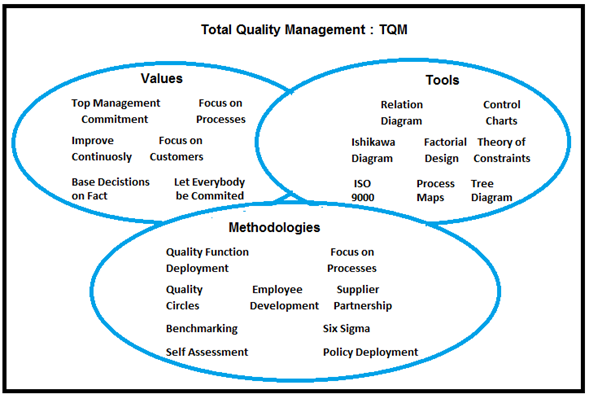- Home
- Continuous Improvement Certification Online
- Total Quality Management Structure
total quality management structure
TQM structure mainly integrates Three structures
TQM mainly integrates three principles:
- Staff participation.
- Customer satisfaction.
- Continuous improvement.

- Staff Participation requires the organization's human resources to be actively involved, fully aware of their task and in the achievement of organizational objectives. The staff is a fundamental resource in any type of organization.
- The second point to consider is customer satisfaction. We can define it, in terms of the ISO 9000 Standard, as “the customer's perception of the degree to which their requirements have been met (established need or expectation, generally implicit or mandatory)”. This point is easy to achieve if we work constantly to get to know our clients (current and potential) and we manage to interpret and translate the client's requirements to the characteristics of the goods / services that we offer.
- The third element that must be developed in order to comply with the main factors of Total Quality Management is "continuous improvement", which includes the performance of recurring actions to increase the ability to meet the requirements. This factor is commonly related to the "Deming Cycle", where a virtuous circle is produced that begins with planning and culminates in the review of the results achieved to achieve the unmet objectives or to work on improving the objectives that they have been achieved.
Continuous improvement requires establishing quantifiable objectives to measure the expected results for processes, goods, services and other issues of importance for each organization.
Total quality or Total Quality Management (TQM) is an approach that seeks to improve quality and performance, in order to adjust or exceed customer expectations. This can be achieved by integrating all quality-related functions and processes in one company. TQM monitors all quality measures used by a company, including quality management and development, quality control and maintenance, quality improvement and quality assurance. It takes into account all quality measures at all levels and involves all employees.
Principles of total quality management
TQM can be defined as the management of initiatives and procedures focused on achieving the delivery of quality products and services. Many principles can be identified, including:

- Executive Management: Senior management must act as the main driver of TQM and create an environment that ensures its success.
- Training: Employees must receive regular training in quality methods and concepts.
- Focus on the customer: Quality improvements should improve customer satisfaction.
- Decision making: Decisions for quality must be made based on measurements.
- Methodology and tools: The use of methodologies and tools ensure that quality non-compliances are identified, measured and responded to.
- Continuous improvement: Companies must constantly work to improve manufacturing and quality procedures.
- Organizational culture: The culture of the company should be focused on developing the ability of employees to work together to improve quality.
- Employees involved: Employees must be motivated to be proactive in identifying and addressing quality-related issues.
For the strategic application of TQM, one of the components consists of the core values. The core values constitute the base for the culture of the organization. Another component is methodologies, ways to work within the organization to support the values. A methodology consists of a number of activities performed in a certain order. The third component consists of concrete and well-defined tools, which sometimes have a statistical basis, to support decision making or facilitate analysis of data. These three components are interdependent on each other and support each other.
InArtifexYou has partner up to offer you a world-class programs. Be part of the graduates of the programs that we offer, where it will be a pleasure to listen to you and work together in constructive improvement in terms of knowledge.